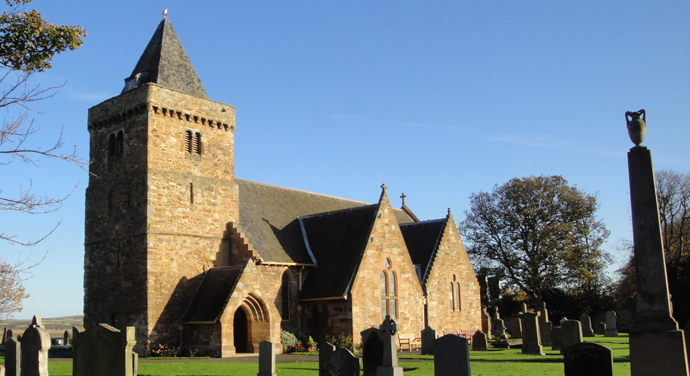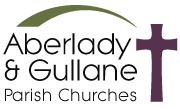
Aberlady Parish Church History
Aberlady, in a range of spellings, features in Church history from the 12th Century. A 1275 letter of Pope Gregory X calls it Aberlefdi. The earliest place of worship in Aberlady might have been a Culdee Chapel, ruins of which were discovered in the north-west corner of the old churchyard when the Luffness burial ground was established at the time of the Reformation.
The history of Aberlady Parish Church dates back to about 1452 when the records of the Bishop of Dunkeld show that a watch tower was built, to which a church was added and that a chancel was a further addition in 1509.
Later in the 16th century an aisle, known as the Ballencreiff Aisle was built onto the northeast side followed in the 17th century by the Gosford Aisle on the north-west side. This 15th century church lasted until 1773 when it was replaced by what became known as the “square kirk” due to its dimensions. Only the tower, the two aisles and a small fragment of wall which contained a 1723 grave stone, situated outside the south east corner, survived from the earlier church.
The 1773 Church lasted until 1886 when the 10th Earl of Wemyss, one of the Heritors, decided to replace it with a more attractive building. It was demolished, again leaving only the tower, north aisles and previously mentioned fragment of wall. The new church, designed by London architect William Young opened for worship on 2 June 1887 and was described in a newspaper of the time as “ one of the finest ecclesiastical buildings in Scotland ”

The new lower roof enhanced the proportions of the tower to which new entrance porches had been added. The new south aisles complemented the original north aisles. A series of stained glass windows depicting the life and teachings of Jesus were commissioned in 1887 and installed later as funds became available. Those in the chancel and south aisles are attributed to Edward Frampton of London whilst those in the north aisle were designed by James Ballantine of Edinburgh.
The most significant window is the centre piece of the chancel window which Frampton copied from Sandro Botticelliʼs painting of the Virgin Adoring the Sleeping Christ, often referred to as The Wemyss Madonna since it had been in Wemyssʼ family possession from 1859 until it was sold in 1999 to The National Gallery of Scotland. The window is also notable for inclusion of the opening musical notes of Handelʼs Messiah.
The Church contains two stunning marble monuments, the oldest of which is in memory of Lady Elibank who died in 1762. Attributed to the Italian sculptor Antonio Canova the epitaph was written by her husband in English and reputedly translated into Latin by the famous Dr. Samuel Johnson.
The second is an effigy of Louisa Bingham, Countess of Wemyss and March, wife of the 9th Earl. Carved by Scotsman John Rhind it was first exhibited in the Edinburgh Exhibition of 1887 then installed in the centre of the chancel. It was moved in 1960 to its present position in the south aisle.
There are several other memorials dedicated to members of the Wemyss family and the Hopes of Luffness as well as former ministers of the church. The finely carved Communion Table, together with the set of chairs were donated in memory of an Elder, Mr. A Stevenson of Luffness.
The Communion pieces currently in use were donated over many decades to the Church, the most significant being four Communion cups given by Sir John Wedderburn of Gosford, physician to King Charles II.
The 8th Century Aberlady Cross.
In 1863 a fragment of an ancient Celtic or probably Anglo-Saxon cross was unearthed in the garden of Aberlady Manse, next to the Church, The intricate carving on the stone shaft is similar to art found in the 7th century Lindisfarne Gospels. The stone was illegally given away by the minister of the time but eventually found its way to the National Museum of Antiquities of Scotland who returned it, under protest, to Aberlady for a short time before recalling it for an exhibition in the Museum where it remains. However an exact copy was given to the Church and is displayed in the chancel along with three heavy oak eldersʼ chairs from the 1773 church.
William Youngʼs design has required little alteration since 1887. In 1961 when the heating system was upgraded the vestry was closed off and used as the boiler room and the base room of the tower became the vestry. The only serious omission in Youngʼs plan is that the Church has no water supply and to this day relies on rain water collected in the tower to supply the boiler.
Two pews were removed from the rear of the centre section for the convenience of the congregation, particularly during winter when gales tend to blow through the north entrance.
In 1986 Aberlady and Gullane Parishes were linked under one Minister and are currently served by the Reverend Brian Hilsley. The Gullane manse was retained for the minister and the Aberlady manse was sold and the Aberlady Kirk Stables Hall was renovated.


